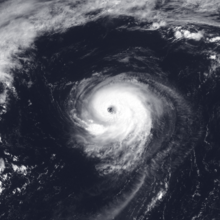 Alberto at peak intensity over the northern Atlantic Ocean on August 12 | |
| Meteorological history | |
|---|---|
| Formed | August 3, 2000 |
| Extratropical | August 23, 2000 |
| Dissipated | August 25, 2000 |
| Category 3 major hurricane | |
| 1-minute sustained (SSHWS/NWS) | |
| Highest winds | 125 mph (205 km/h) |
| Lowest pressure | 950 mbar (hPa); 28.05 inHg |
| Overall effects | |
| Casualties | None Reported |
| Fatalities | None reported |
| Damage | None |
| Areas affected | West Africa, Bermuda, Iceland, Greenland, Jan Mayen |
| IBTrACS | |
Part of the 2000 Atlantic hurricane season | |
Hurricane Alberto was the farthest-travelling tropical cyclone on record in the Atlantic Ocean. The third tropical cyclone, first named storm, and first hurricane of the 2000 Atlantic hurricane season, Alberto developed near the western coast of Africa from a tropical wave on August 3. Initially a tropical depression, it strengthened into Tropical Storm Alberto early on August 4. While briefly turning westward on August 6, Alberto attained hurricane status. The cyclone continued to track west-northwestward, and by early the following day, reached an initial peak with winds of 90 mph (140 km/h). Shortly thereafter, Alberto re-curved northwestward and began encountering increased wind shear. As a result, Alberto weakened back to a tropical storm on August 9. However, the system quickly re-strengthened as winds became more favorable, and early on August 10, Alberto became a hurricane again. The storm gradually curved northward and north-northeastward between August 11 and August 12; Alberto attained its peak intensity with winds of 125 mph (201 km/h) during that time.
Increasing upper-level westerlies caused Alberto to weaken as it moved east-northeastward, with the cyclone losing most of its convection. Early on August 14, Alberto was downgraded to a tropical storm. A westerly trough that had been guiding Alberto outran the storm, and strong ridging developed to the north and west. As a result, Alberto turned southward on August 15, southwestward on August 16, and then to the west on August 17. While curving northwestward and then northward, Alberto began to re-strengthen, and was upgraded to a hurricane for a third time on August 18. Alberto reached a third peak intensity as a Category 2 hurricane with winds of 105 mph (169 km/h) on August 20. After weakening back to a Category 1 hurricane, Alberto conducted an unusually large cyclonic loop, spanning approximately 5 degrees latitude and 8 degrees longitude.[1] The cyclone was downgraded to a tropical storm on August 23, shortly before completing its extratropical transition. Although it did not affect land while tropical, the precursor tropical wave caused light rainfall in Senegal. The remnant extratropical cyclone also likely produced tropical storm-force winds in Iceland and Jan Mayen.
- ^ Gary L. Padgett (2001). "Monthly Global Tropical Cyclone Summary—August 2000". Archived from the original on March 16, 2006. Retrieved October 7, 2010.